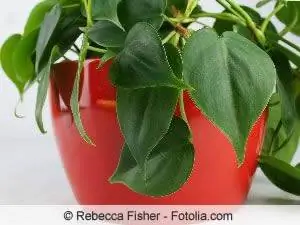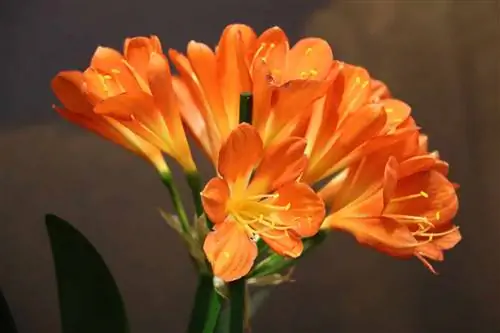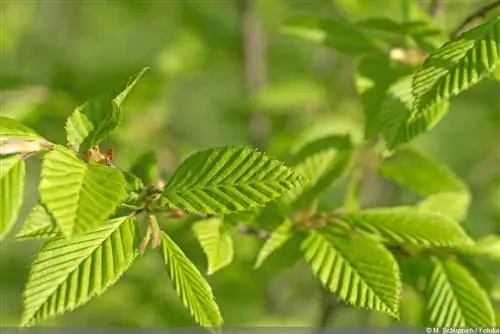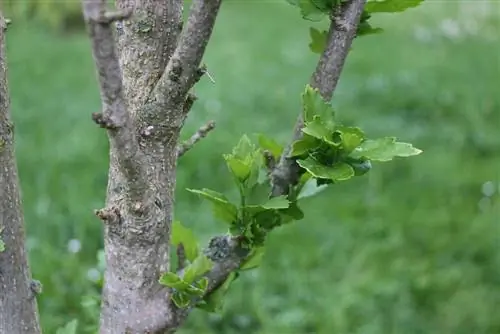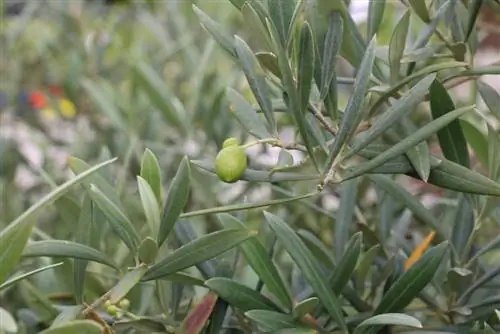- Author admin [email protected].
- Public 2023-12-17 03:39.
- Last modified 2025-01-24 12:45.
The light only occasionally penetrates to the ground in the rainforest. Almost everything under the dense treetops is shrouded in light shadow. In order to survive, plants have to develop very special strategies to get the desired sunlight. Many plants do not grow on the ground, but rather sit on the branches of trees. Others are in the ground, but use the trees as climbing frames to get to the top as quickly as possible.
Special living conditions in the tropical rainforest
The world's most important virgin forests: the tropical rainforests, stretch out on both sides of the equator in the warm, always humid regions. Of the approximately 300,000 plant species discovered to date, around two thirds are native to the tropical rainforest.
Depending on the altitude at which the rainforest grows, a distinction is made between:
- Mangrove forests (near the coast)
- Lowland rainforests
- Mountain Rainforests
Typical rainfall amounts for tropical rainforests range between 2,000 and 10,000 millimeters per year. Temperatures are around 25 degrees all year round. The vegetation in the tropical rainforest is divided into characteristic levels.
- upper floor: isolated trees up to 60 meters high
- Crown region: Trees with a dense canopy, main canopy of the rainforest, up to about 40 meters high
- middle floor: consists of young trees, tall bushes, tree ferns, very rich in species
- Shrub layer: shrubs and young trees up to about 5 meters
- Herb layer: the regions below only receive around 1-3% sunlight; almost only ferns, mushrooms and mosses grow here
The soils in rainforests, which have mostly existed for millions of years, are generally very poor in nutrients.
Herb layer with mosses and ferns
When it comes to mosses and ferns, between 75 and 90% of all known species come from tropical rainforests. One of the most impressive specimens are the tree ferns, whose feathery leaves can reach up to four meters in length. Around 3000-4000 species of mosses are native to the rainforest.
Examples of Ferns:
- Striped ferns (Aspleniaceae) such as the nest fern (Asplenium nidus)
- Tree Ferns (Cyatheales, Dicksoniaceae)
- Spotted ferns (Polypodium, Lindsaeaceae)
- Fern family (Dennstaedtiaceae)
- Worm fern family (Dryopteridaceae)
- Clover fern family (Marsileaceae)
- Sword ferns (Nephrolepidaceae)
- Ophioglossaceae
Other herbaceous plants
- Horsetails (Equisetaceae)
- Bream herbs (Isoëtaceae)
- Clubmosses (Lycopodiaceae)
- Moss Ferns (Selaginellaceae)
climbing plants
Probably the best-known climbing plants are the lianas, which become woody over time and can grow up to 300 meters long. When it comes to climbing plants, there are a number of different methods by which the plants cling to a tall tree. Vines usually have corkscrew-like shoots that they use to hold on. Spreading climbers attach themselves to the ground with spines or thorns. Climbers have no developed climbing organs; the entire plant shoot winds itself around vertical climbing aids (trees and bushes).
Lianas include some species of the genera:
- Caper family (Capparaceae)
- Spindle tree family (Celastraceae)
- Trumpet tree family (Bignoniaceae)
- Bauhinias, orchid trees (Bauhinia)
- Bottle tree family, scale apple family (Annonaceae)
- Soap tree, sumac family (Anacardiaceae)
Well-known climbing plants from the tropical rainforest:
- Window leaf (Monstera deliciosa)
- some flamingo flowers (like Anthurium scandens)
- Ivy plant (Epipremnum aureum)
- Tree friend (Philodendron)
- Passionflower family (Passifloraceae) such as passion fruit or passion fruit
Epiphytes
Plants that can't climb have come up with something else. They simply sit on the branches of trees to get the desired light. The seeds of these epiphytes are often carried to the upper levels of the rainforest by birds. In the course of evolution, these epiphytes have developed a wide variety of strategies to become independent of the soil's water and nutrient supply.
Orchids
Orchids include around 30,000 species, most of which are native to tropical rainforests. Some types of orchids form freely hanging aerial roots with which they can literally absorb rainwater. However, orchids are not parasitic plants that feed on the tree on which they live. They merely cling to the bark of trees to be closer to vital sunlight. They get their water and nutrients primarily from the rain or fog that occurs here every day. Popular Types:
- Phalaenopsis
- Vanda
- Dendrobium
- Real Vanilla
Bromeliads, pineapple family (Bromeliaceae)
Bromeliads also grow as epiphytes on trees in the tropical rainforest. The funnel-shaped leaves collect rainwater and nutrients from blown particles. In the pineapple family, the leaves are covered with so-called suction scales. These scales swell as soon as they are wetted with rainwater. The plants provide a habitat for microorganisms but also frogs, which lay their eggs in the water reservoirs. By the way, tillandsias also belong to the bromeliad family.
- Guzmania
- Billbergia (room oats)
- Neoregelia
- Tillandsia (Tillandsia)
More epiphytes
- Arum family (Araceae)
- Spearleaf (Anubias)
- Flamingo flower (Anthurium)
- Green lilies (Chlorophytum comosum)
- Dwarf pepper (Peperomia)
- Shames (Aeschynanthus)
Halfpiphytes
In addition to the actual epiphytes, which spend their entire life on a larger plant, there are also some specialized plants that only spend there up to (or from) a certain age. These include, for example, two well-known plants:
Strangler Fig
The life of a strangler fig begins as a seed on a branch of a large tree. At first it grows there as a simple epiphyte. If a strangler fig grows and thrives well, this is almost always associated with the death of its host tree. As soon as the strangler fig has developed enough of its own stilt roots, it begins to strangle its host. The strangler figs include various species of the genus Ficus.
Monstera
Some representatives of the genus Monstera (window leaf) germinate on the ground and initially go in search of a larger tree. Only there do the real leaves form. When climbing, Monstera forms two different types of roots: adherent roots and long, very fast-growing aerial roots. They enable the plant to reach the ground from over 30 meters and absorb nutrients and water there, even if the lower part of the plant has already died.
Parasite Plants
Other plants don't even try to survive on their own. They feed on other plants.
- Rafflesia (Rafflesia)
- Corynaea crassa (from the Balanophoraceae family)
Plants from the understory
In tropical rainforests, the amount of light reaching the ground is much lower than in our deciduous forests. As a result, there is a lower diversity of herbaceous ground growth there. Many of these plants are popular with us as houseplants because of their low light requirements:
- Begonias (Begonia)
- Aroid family (Araceae) such as the single leaf (Spathiphyllum), flax filament (Aglaonema)
- Flamingo flowers (Anthurium)
- Dieffenbachia (Dieffenbachia)
- Arrowroot family (Marantaceae) such as the basket marant (Calathea Zebrina)
- Sorrel family like Biophytum sensitivum
- Arrow leaves (Alocasia)
- Radiated aralia (Schefflera), sometimes also climbing plants
- Rough leaf family, borage family (Boraginaceae)
- Swan Flower (Butomaceae)
- God's eyes (Tradescantia) like the zebra ampelwort (Tradescantia zebrina)
- Dwarf pepper (Peperomia) like Peperomia caperata
- Silver Net Leaf (Fittonia)
Palm trees and bamboo
In addition, different palm trees and bamboo species (such as the giant bamboo) are also typical representatives of the tropical rainforest. But plant species that are planted in Central European gardens can also be found in the rainforest, such as the boxwood family (Buxaceae). Today more than 200 species of palm trees with around 2,500 subspecies are known. Most palm trees are at home in tropical rainforests because they require a lot of warmth and moisture, but also a little more light than other plants that occur there. That's why they are usually found in clearings or on the edge of the rainforest. Palm trees with low light requirements:
- Mountain palm (Chamaedorea elegans)
- Large ray palm (Licuala grandis)
- Kentia palm (Howea fostweriana)
- Australian umbrella palm (Livistona australis)
Carnivorous plants
A very special type of plant that occurs in the tropical rainforest are carnivorous plants. These include, for example:
- Pitcher plants (Nepenthes)
- Pitch plants (Sarracenia) like Sarracenia purpurea
Crops
Many plants that we know as spices or fruits, or whose wood is used to make furniture, come from the tropical rainforest. To name just a few examples:
- Banana (grows in clearings)
- Cinnamon
- Ginger
- Papaya (Carica papaya)
- Real Vanilla
- Mahogany tree
Conclusion
There is incredible biodiversity in the tropical rainforest. The individual plants have become extremely specialized due to the unfavorable soil and site conditions. The plants often only occur once within a radius of several hundred meters; large collections of the same species are very rare. Some plants are very shade tolerant, others produce beautiful flowers and are therefore popular as houseplants. They all like it warm and rather humid all year round.

